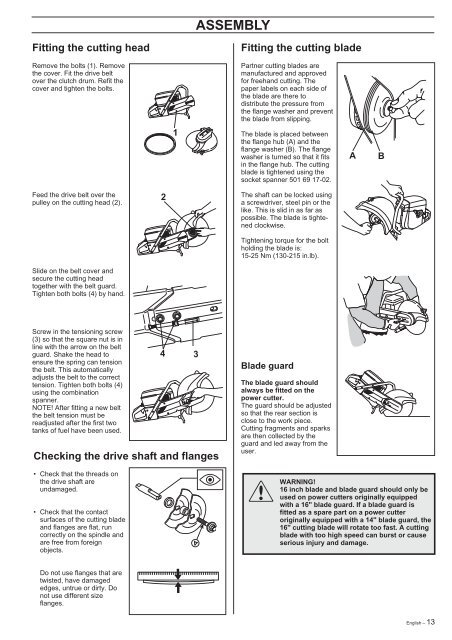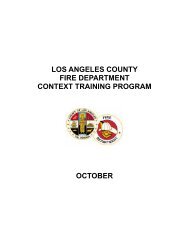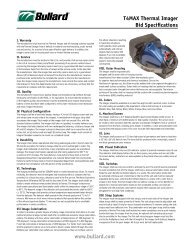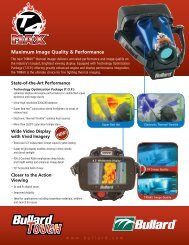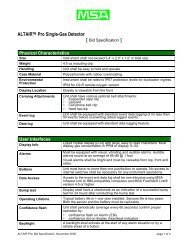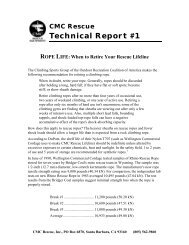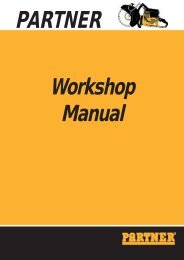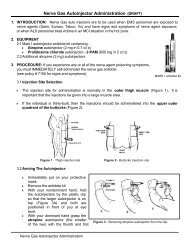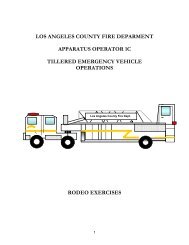PARTNER K950 Operators Manual 1998.pdf
PARTNER K950 Operators Manual 1998.pdf
PARTNER K950 Operators Manual 1998.pdf
Create successful ePaper yourself
Turn your PDF publications into a flip-book with our unique Google optimized e-Paper software.
ASSEMBLY<br />
Fitting the cutting head<br />
Fitting the cutting blade<br />
Remove the bolts (1). Remove<br />
the cover. Fit the drive belt<br />
over the clutch drum. Refit the<br />
cover and tighten the bolts.<br />
Partner cutting blades are<br />
manufactured and approved<br />
for freehand cutting. The<br />
paper labels on each side of<br />
the blade are there to<br />
distribute the pressure from<br />
the flange washer and prevent<br />
the blade from slipping.<br />
1<br />
The blade is placed between<br />
the flange hub (A) and the<br />
flange washer (B). The flange<br />
washer is turned so that it fits<br />
in the flange hub. The cutting<br />
blade is tightened using the<br />
socket spanner 501 69 17-02.<br />
A<br />
B<br />
Feed the drive belt over the<br />
pulley on the cutting head (2).<br />
Slide on the belt cover and<br />
secure the cutting head<br />
together with the belt guard.<br />
Tighten both bolts (4) by hand.<br />
2<br />
The shaft can be locked using<br />
a screwdriver, steel pin or the<br />
like. This is slid in as far as<br />
possible. The blade is tightened<br />
clockwise.<br />
Tightening torque for the bolt<br />
holding the blade is:<br />
15-25 Nm (130-215 in.lb).<br />
Screw in the tensioning screw<br />
(3) so that the square nut is in<br />
line with the arrow on the belt<br />
guard. Shake the head to<br />
ensure the spring can tension<br />
the belt. This automatically<br />
adjusts the belt to the correct<br />
tension. Tighten both bolts (4)<br />
using the combination<br />
spanner.<br />
NOTE! After fitting a new belt<br />
the belt tension must be<br />
readjusted after the first two<br />
tanks of fuel have been used.<br />
4 3<br />
Checking the drive shaft and flanges<br />
Blade guard<br />
The blade guard should<br />
always be fitted on the<br />
power cutter.<br />
The guard should be adjusted<br />
so that the rear section is<br />
close to the work piece.<br />
Cutting fragments and sparks<br />
are then collected by the<br />
guard and led away from the<br />
user.<br />
• Check that the threads on<br />
the drive shaft are<br />
undamaged.<br />
• Check that the contact<br />
surfaces of the cutting blade<br />
and flanges are flat, run<br />
correctly on the spindle and<br />
are free from foreign<br />
objects.<br />
!<br />
WARNING!<br />
16 inch blade and blade guard should only be<br />
used on power cutters originally equipped<br />
with a 16" blade guard. If a blade guard is<br />
fitted as a spare part on a power cutter<br />
originally equipped with a 14" blade guard, the<br />
16" cutting blade will rotate too fast. A cutting<br />
blade with too high speed can burst or cause<br />
serious injury and damage.<br />
Do not use flanges that are<br />
twisted, have damaged<br />
edges, untrue or dirty. Do<br />
not use different size<br />
flanges.<br />
English – 13


